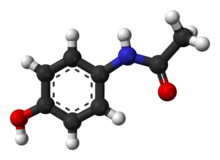 | |
 | |
| Clinical data | |
|---|---|
| Pronunciation | Paracetamol: /ˌpærəˈsiːtəmɒl/ Acetaminophen: /əˌsiːtəˈmɪnəfɪn/ |
| Trade names | Tylenol, Panadol, others[1] |
| Other names | N-acetyl-para-aminophenol (APAP), acetaminophen (USAN US) |
| AHFS/Drugs.com | Monograph |
| MedlinePlus | a681004 |
| License data |
|
| Pregnancy category |
|
| Routes of administration | By mouth, through the cheek, rectal, intravenous (IV) |
| Drug class | Analgesics, antipyretics |
| Legal status | |
| Legal status |
|
| Pharmacokinetic data | |
| Bioavailability | 63–89%[3]: 73 |
| Protein binding | 10–25%[4] |
| Metabolism | Predominantly in the liver[8] |
| Metabolites | APAP gluc, APAP sulfate, APAP GSH, APAP cys, NAPQI[5] |
| Onset of action | Pain relief onset by route: By mouth – 37 minutes[6] Buccal – 15 minutes[6] Intravenous – 8 minutes[6] |
| Elimination half-life | 2–2.5 hours[7] |
| Excretion | Urine (85–90%)[8] |
| Identifiers | |
| |
| Chemical and physical data | |
| Formula | C8H9NO2 |
| Molar mass | 151.163 g·mol−1 |
| 3D model (JSmol) | |
| Density | 1.263 g/cm3 |
| Melting point | 169 °C (336 °F) [9][10] |
| Boiling point | 420 °C (788 °F) |
| Solubility in water | |
| |
| |
| (verify) | |
Paracetamol, also known as acetaminophen, is a medication used to treat pain and fever.[15][16] It is typically used for mild to moderate pain relief.[15] Evidence is mixed for its use to relieve fever in children.[17][18] It is often sold in combination with other medications, such as in many cold medications.[15] Paracetamol is also used for severe pain, such as cancer pain and pain after surgery, in combination with opioid pain medication.[19] It is typically used either by mouth or rectally, but is also available by injection into a vein.[15][20] Effects last between two and four hours.[20]
Paracetamol is generally safe at recommended doses.[13][21] The recommended maximum daily dose for an adult is three to four grams.[22][23][21] Higher doses may lead to toxicity, including liver failure.[15] Serious skin rashes may rarely occur.[15] It appears to be safe during pregnancy and when breastfeeding.[15] In those with liver disease, it may still be used, but in lower doses.[24] It is classified as a mild analgesic.[20] It does not have significant anti-inflammatory activity.[25] How it works is not entirely clear.[25][26][27]
Paracetamol was first made in 1877.[28] It is the most commonly used medication for pain and fever in both the United States and Europe.[29] It is on the World Health Organization's List of Essential Medicines.[30] Paracetamol is available as a generic medication, with brand names including Tylenol and Panadol among others.[31] The wholesale price in the developing world is less than US$0.01 per dose.[32] In the United States, it costs about US$0.04 per dose.[33] In 2017, it was the 25th-most commonly prescribed medication in the United States, with more than 24 million prescriptions.[34][35]